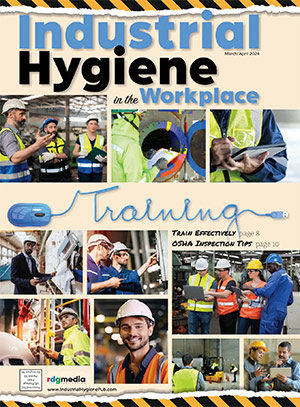How Has COVID-19 Affected Environmental Compliance?

By: Justin Scace, Contributor
The global COVID-19 pandemic has thrown a spotlight on the modern environmental, health and safety (EHS) function—and its professionals—more than ever before. COVID-19’s impact on employee health and safety is often discussed, but what about the impacts on environmental compliance?
As we near the two-year anniversary of the declaration of COVID-19 as a worldwide pandemic, we have learned a great deal about how this milestone event has affected the environment and how these events have changed the course of organizational EHS. Here, we take a look at how the pandemic has affected key challenges, including waste, management systems and the environmental profession as a whole.
Negative (and Positive) Environmental Impacts

An MIT analysis estimates the pandemic could generate up to 7,200 tons of medical waste per day. © JJ Gouin – stock.adobe.com
Multiple reviews of the available scientific literature have identified both positive and negative impacts to the environment in the wake of COVID-19. A variety of factors contributed to these effects, including the slowing of economic activity; fewer motor vehicles on the road; and increased usage of personal protective equipment (PPE) and other medically necessary practices as the virus spread.
Positive environmental impacts included:
- A decrease in fuel consumption as well as reductions in greenhouse gas (GHG) and other emissions. To cite just one example, nitrogen dioxide (NO2) emissions in the U.S., 80% of which come from motor vehicle exhaust according to the Environmental Protection Agency (EPA), dropped 25.5% in the early months of the pandemic compared with historical data.
- Reduced noise pollution and ecological restoration. The decreased mobility caused by the pandemic reduced noise from traffic and resulted in evidence of ecological restoration, especially in tourist destinations that had been heavily trafficked, pre-COVID.
- Improved water quality. Reduced industrial activity resulted in improved water quality, especially in countries with minimal or no wastewater treatment protocols.
Negative environmental impacts included:
- A vast increase in medical waste. The COVID-19 crisis resulted in a large increase in medical waste, which in turn may present environmental compliance challenges (discussed further below).
- Soil and water pollution from plastic waste, especially discarded PPE. Beyond medical waste, increased consumption of PPE led to haphazard disposal after use, resulting in pollution issues.
- Disruption of recycling activities. As medical and municipal waste increased amid the pandemic, waste management organizations were disrupted the same as all other businesses. One study cites a nearly 46% restriction of recycling programs in the U.S. due to fears of the virus spreading in recycling facilities.
Compliance and Management System Challenges

The use of PPE, especially masks, creates waste across businesses and in individual households. Environmental professionals must consider what this means for sustainability efforts and solid waste programs. (photo courtesy Adobe Stock)
In the early months of the pandemic, the EPA issued a temporary enforcement policy that provided some leniency for organizations struggling with logistical disruptions in compliance, such as travel restrictions and facility shutdowns. Yet, while this policy expired over a year ago, COVID-19 remains with us. This presents many challenges for environmental professionals.
The telework revolution brought on by the pandemic is not ubiquitous in the EHS space, as its feasibility depends on the specifics of an operation and its compliance obligations. While many environmental monitoring systems, as well as certain recordkeeping and reporting duties, may be managed remotely, other potential requirements, such as environmental inspections (e.g., of central accumulation areas for hazardous waste) or function-specific training for hazmat employees, must be done completely or partially in person.
Voluntary environmental management systems (EMSs), such as ISO 14001, also saw the need to adapt in the face of COVID-19. Auditing plays a strong role in these systems, and the International Organization for Standardization (specifically, the ISO 9001 Auditing Practices Group) issued guidance for remote audits early on, in April of 2020. These practices rely heavily on information and communication technologies (ICT) and, while larger organizations may have these resources at the ready, small- to mid-sized businesses may face challenges investing in and implementing appropriate ICT tools. Further, many sustainability programs related to EMSs require partnerships with and audits of third parties and vast supply chains—many of which faced partial or full shutdowns during the pandemic.
Environmental compliance is also challenged by all the other day-to-day business disruptions presented by COVID-19. Staffing shortages due to exposure or sickness pose threats on multiple fronts; employees who are overworked, rushed or distracted may cut corners with hazardous materials or other compliance procedures. If the organization has a small EHS staff, it can get very messy, should COVID find its way into the team.
Without ownership of the function for a period of time, environmental compliance is likely to suffer. Beyond individual organizations, these same challenges extend to every other layer of compliance, including permit writers, waste transporters, agency inspectors and source testers.
Plan for Continued Disruption
While vaccination efforts and new treatments have provided some positive headway against the pandemic, it’s likely that COVID-19 will be here to stay, as new variants emerge and the virus eventually becomes endemic. It’s important that environmental compliance professionals plan to experience continued disruption amid regular enforcement activity.
The following best practices are essential:
- Ensure that every environmental compliance task has an owner and that there is at least one backup for each owner. This may be particularly challenging for small teams or environmental “departments of one.” Look to your operations and health and safety teams (if separate from environmental) for those willing to learn about compliance tasks and cross-train in the event of a problem. In fact, this should remain a best practice, even post-pandemic.
- Keep lines of communication open across your supply chain. Third-party vendors and providers are equally vulnerable to COVID-19, so ensure that you remain in contact with key stakeholders to keep operations, such as waste management and water-quality sampling, as seamless as possible—and know who to talk to and what to do should something go wrong.
- Assess processes and upcoming obligations to mitigate the impact of disruption from COVID-19. Review all permits with an eye for when renewals are due; check to ensure that waste is shipped offsite on time according to regulations and your generator category; and know what else may be upcoming on your compliance calendar. Also, review to see if anything has changed at your organization due to COVID-19 that may cause you to re-evaluate your compliance tasks, especially when it comes to waste.
Waste, Waste and More Waste
Perhaps no aspect of environmental compliance has been more complicated by COVID-19 than waste. Medical facilities have seen an increase in waste output, and other organizations may have created entirely new waste streams during the pandemic. Here are just a few of the ways COVID-19 has affected waste considerations.
- Medical waste. According to an MIT analysis published in the British Medical Journal Open, the pandemic could generate up to 7,200 tons of medical waste per day. While a large portion of this is made up of disposable masks, waste from testing and vaccination also plays a part. The issue may extend beyond hospitals and other medical facilities, as some organizations have set up onsite testing and vaccination clinics. While these are often conducted by third-party providers, environmental professionals should communicate with these partners so it is clear who takes ownership of the resulting waste management, including considerations surrounding sharps bins, bloodborne pathogen control, as well as any additional state regulations governing the handling of medical waste.
- Hygiene takes center stage during a pandemic, and disinfectant use has skyrocketed. EPA’s List N: Disinfectants for Use Against SARS-CoV-2 provided a reliable resource for selecting products, but when introducing new chemicals into the workplace, environmental compliance pros must consider potential impacts to wastewater, as well as disposal of unused chemicals.
- The use of PPE, especially masks, creates waste across businesses and in individual households. Efforts to reduce plastic waste in particular have been affected by COVID-19; while there may be fewer plastic bags and utensils, they have been replaced in the waste stream by single-use polypropylene masks. Environmental professionals must consider what this means for their sustainability efforts as well as their solid waste programs.
Looking to the Future
As of this writing, the omicron variant poses another potential obstacle as case numbers increase ahead of 2022, with the possibility of further variants still an ongoing risk. Despite the enduring challenge of COVID-19, environmental compliance obligations must remain a priority for organizations large and small. With proper due diligence and planning for the worst, environmental professionals can have confidence that their efforts will result in the best possible outcome for their programs.
About the Author:
Justin Scace is an Environmental Editor on the EHS content team at J. J. Keller & Associates, Inc., where he researches, writes and edits content on a wide variety of topics concerning environmental compliance and best practices, from regulatory developments to waste management to sustainability. He is an editor and contributor for J. J. Keller’s Environmental Regulatory Alert newsletter.
Share on Socials!
Heat Stress Monitoring Program Solutions
Navigating Laboratory Safety During a Pandemic
A Checklist for Selecting a Safe & Reliable Respirator
Leaders in Industrial Hygiene
Council for Accreditation in Occupational Hearing Conservation (CAOHC)
Subscribe!
Sign up to receive our industry publications for FREE!







